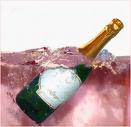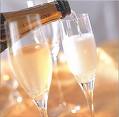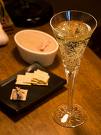If you think you are too bummed out by the current economic  climate to pony up for a bottle of holiday Champagne this year, I want to try to change your mind. My two-pronged strategy involves a brief financial argument and a more extended case for Champagne's unique, indispensable greatness.
climate to pony up for a bottle of holiday Champagne this year, I want to try to change your mind. My two-pronged strategy involves a brief financial argument and a more extended case for Champagne's unique, indispensable greatness.
I am of course aware that the sky is falling in financial terms. However, the fact remains that a good bottle of Champagne is not really all that expensive.
This is a fact that the big Champagne houses have obscured with decades of arguably wrongheaded advertising. Rather than using ads to teach the world that Champagne is a superb, highly  versatile wine, the big houses have tried to outdo one another in identifying their product as a luxury item akin to a Rolex or a Bentley. This was perhaps a plausible strategy in the late 1990s, but it looks pretty daft right now as we teeter on the edge of the abyss.
versatile wine, the big houses have tried to outdo one another in identifying their product as a luxury item akin to a Rolex or a Bentley. This was perhaps a plausible strategy in the late 1990s, but it looks pretty daft right now as we teeter on the edge of the abyss.
However, there's no reason why you or the product itself should suffer because of the dubious strategies of Champagne sales agents. The truth of the matter is that a very good bottle of non-vintage Champagne costs less than most entry-level bottles of Cabernet from Napa--and much less than most 'Reserve' Cabs. For example, Piper-Heidsieck NV Brut (which is tasting very good right now) is being sold where I live (in Washington, DC) for $30, and multiple online retailers are offering it for $25 plus shipping.
I know that $25 or $30 is nothing to sneeze at, but it seems to  me that it doesn't make sense on an important holiday to buy a $9 bottle of Cava or a $12 bottle of Prosecco rather than a delicious bottle of true Champagne. Sure, if you need a bunch of bottles for a party where people won't be attentive to what they're drinking, then buy Cava or Prosecco. But for a single celebratory bottle, buy Champagne. You can balance accounts in January with a couple of nights of tuna casserole and beer.
me that it doesn't make sense on an important holiday to buy a $9 bottle of Cava or a $12 bottle of Prosecco rather than a delicious bottle of true Champagne. Sure, if you need a bunch of bottles for a party where people won't be attentive to what they're drinking, then buy Cava or Prosecco. But for a single celebratory bottle, buy Champagne. You can balance accounts in January with a couple of nights of tuna casserole and beer.
At the risk of pushing my luck, I'd also encourage you to take a step up in the hierarchy if you are just getting to know  Champagne. If you've only had non-vintage Champagne, you will someday need to try vintage-dated bottles or Cuvée de Prestige wines to understand why Champagne is so deeply adored by people like me who have the ridiculous good luck to drink terrific wine every day. This may not be the time for you to make that leap, but if you are prepared to brave four nights rather than two of tuna casserole and beer, this could be your year.
Champagne. If you've only had non-vintage Champagne, you will someday need to try vintage-dated bottles or Cuvée de Prestige wines to understand why Champagne is so deeply adored by people like me who have the ridiculous good luck to drink terrific wine every day. This may not be the time for you to make that leap, but if you are prepared to brave four nights rather than two of tuna casserole and beer, this could be your year.
To backtrack a bit, I'm aware that what I'm writing here must seem thoroughly insane to you if you've never tried a bottle of good Champagne. If your only experience with sparkling wine is the hideous swill poured for toasts at weddings, you'd rightly dismiss all the hubbub about Champagne as effete foolishness.
Moreover, if you've tasted solid sparkling wines and reasonably good Champagnes but never had a truly great one, you might be tempted to dismiss the whole category as something less than real wine. I have heard real people make statements to this effect. That's right: I've heard otherwise sensible people (mostly men) claim that Champagne is not real wine.
On the contrary, there are actually very good reasons to believe that Champagne is the world's greatest wine.
Excellent Champagne can provide innumerable aromatic  nuances. It can deliver remarkable depth and persistence of flavor while remaining restrained in intensity and delicate in body. Its subtle power is demonstrated by its (underappreciated) ability to stand up to many foods, and to develop positively over many years of ageing. No other wine is as invigorating, and no wine can match it for textural complexity. Period.
nuances. It can deliver remarkable depth and persistence of flavor while remaining restrained in intensity and delicate in body. Its subtle power is demonstrated by its (underappreciated) ability to stand up to many foods, and to develop positively over many years of ageing. No other wine is as invigorating, and no wine can match it for textural complexity. Period.
Champagne's amazing versatility can be grasped by simply recognizing that it is not only one of the most food-friendly of all the world's wines, but also simply the best of all aperitifs. For sipping before dinner or as a partner for hors d'oeuvres, only Riesling or dry Sherry come anywhere close to Champagne. Its naturally high acidity provides a powerful stimulus to the appetite, and its effervescence makes Champagne peerless as a palate  refresher. There is simply no better way to assure the success of a dinner party than by using the Pavlovian power of a popping cork, and when you hand a guest a foaming flute of Champagne, you tell them that you regard their arrival as a special occasion without having to say a word.
refresher. There is simply no better way to assure the success of a dinner party than by using the Pavlovian power of a popping cork, and when you hand a guest a foaming flute of Champagne, you tell them that you regard their arrival as a special occasion without having to say a word.
And yet, it is also terrific with food. The appearance of Champagne may prove surprising at the dinner table, but surprises are an important part of enjoyable dining, and the wine will convince any skeptics if paired with the right foods. There are many 'right foods' beyond classic partners like oysters or caviar. Champagne's effervescence makes it a perfect textural foil for almost any soup, whether based on broth or cream (or tomatoes, for that matter; Champagne rocks with gazpacho). Moreover,  Champagne's strong natural acidity neutralizes vinegar in a way that makes it ideal with salads. It is wonderful with almost any finfish that is either poached, sautéed or fried (though not grilled), and it is downright incredible with sushi and sashimi. Champagne works very well with lighter preparations of chicken, pork or veal, and is fantastic with white sausages (boudin blanc to the French or weisswurst to the Germans). It is also excellent with rice, pasta, eggs and many vegetarian foods.
Champagne's strong natural acidity neutralizes vinegar in a way that makes it ideal with salads. It is wonderful with almost any finfish that is either poached, sautéed or fried (though not grilled), and it is downright incredible with sushi and sashimi. Champagne works very well with lighter preparations of chicken, pork or veal, and is fantastic with white sausages (boudin blanc to the French or weisswurst to the Germans). It is also excellent with rice, pasta, eggs and many vegetarian foods.
I could go on, but you get the idea. If you haven't tried Champagne with food, here are a few practical guidelines: Lighter, Chardonnay-based Blanc de Blancs bottlings make a  particularly wonderful aperitif, though blended Bruts and Rosés work well too, and are actually preferable if more substantial hors d'oeuvres will be in play. With subsequent courses, you should simply follow the basic principle for pairing any wine with food, which is to seek symmetry between the robustness of the two. That is, with lighter and more delicate foods, use lighter bodied, subtly flavored Champagnes; with more robust foods, choose richer, more assertive Champagnes.
particularly wonderful aperitif, though blended Bruts and Rosés work well too, and are actually preferable if more substantial hors d'oeuvres will be in play. With subsequent courses, you should simply follow the basic principle for pairing any wine with food, which is to seek symmetry between the robustness of the two. That is, with lighter and more delicate foods, use lighter bodied, subtly flavored Champagnes; with more robust foods, choose richer, more assertive Champagnes.
One last way to make the case for Champagne as the world's greatest wine is to observe that it is amazingly durable, age- worthy stuff. The power of these wines is under-appreciated by almost everyone who isn't fairly expert about wine, largely because it is so counter-intuitive. A light, delicate, fluffy little wine have durability, could it? Damn right it could! As my WRO colleague Ed McCarthy will attest, many of the best Champagnes from the 1996 vintage are only now starting to hit their prime. Some of these will not hit their peak for another decade. And there are wines from the 1988 vintage that still haven't peaked.
worthy stuff. The power of these wines is under-appreciated by almost everyone who isn't fairly expert about wine, largely because it is so counter-intuitive. A light, delicate, fluffy little wine have durability, could it? Damn right it could! As my WRO colleague Ed McCarthy will attest, many of the best Champagnes from the 1996 vintage are only now starting to hit their prime. Some of these will not hit their peak for another decade. And there are wines from the 1988 vintage that still haven't peaked.
The very best bottles of Bordeaux and Barolo can be as age-worthy as top Champagnes, but they are no more durable in my view, as a 30 year-old bottle of a top-notch Champagne will have gained as much complexity as these reds over time but still retain more freshness and snap.
 So there you have it. Pony up for the Good Stuff this holiday season, and I'll meet you back here in the new year to talk about bargain wines to help deal with the recession. But until then, Cheers!
So there you have it. Pony up for the Good Stuff this holiday season, and I'll meet you back here in the new year to talk about bargain wines to help deal with the recession. But until then, Cheers!